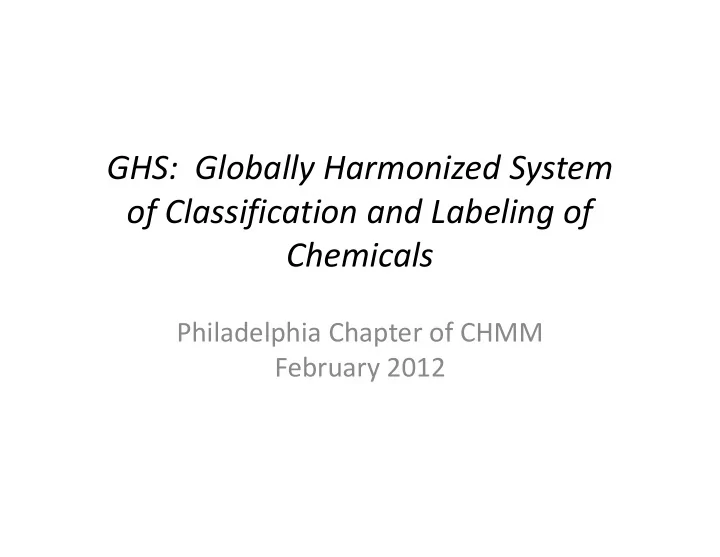

GHS: Globally Harmonized System of Classification and Labeling of Chemicals Philadelphia Chapter of CHMM February 2012
International Mandate from UNCED Agenda 21, Chapter 19 “A globally harmonized hazard classification and compatible labeling system, including material safety data sheets and easily understandable symbols, should be available, if feasible, by the year 2000.“
Why Change? • Many countries already have regulatory systems • Laws and regulations are similar, however; they are different enough to require multiple labels for the same product in the U.S. and in international trade. • These differences may require multiple safety data sheets for the same product in international trade • Differences exist in definitions as well as for information to be included on labels or material safety data sheets • Targeted Sectors: – Transport – Consumer – Workplace – Pesticides
Inconsistencies Lead To… • inconsistent protection for those potentially exposed to the chemicals • creating extensive regulatory burdens on companies producing chemicals
Benefits of Globalization • The goal of hazard communication is to ensure that employers, employees and the public are provided with adequate, practical, reliable and comprehensible information on the hazards of chemicals. • This provides effective preventive and protective measure for health and safety. • Implementation of effective hazard communication provides benefits for governments, companies, workers, and members of the public.
Benefits, Specifically To governments – Fewer chemical accidents, and thus, lower health care costs – Avoiding duplication of effort in creating national systems – Reduction in the costs of enforcement To companies – A safer work environment and improved relations with employees – An increase in efficiency and reduced costs from compliance with hazard communication regulations – Reduced costs due to fewer accidents and illnesses To workers and members of the public – Improved safety for workers and others through consistent and simplified communications on chemical hazards and practices to follow for safe handling and use – Greater awareness of hazards, resulting in safer use of chemicals in the workplace and in the home
The GHS is Not a Regulation or a Standard • The GHS establishes agreed hazard classification and communication provisions with explanatory information on how to apply the system • Existing systems included in the harmonization process – UN Transport Recommendations – U.S. Requirements for Workplace, Consumer and Pesticides – European Union Dangerous Substance and Preparations Directives – Canadian Requirements for Workplace, Consumers and Pesticides • The Department of Transportation (DOT), Environmental Protection Agency (EPA), and the Consumer Product Safety Commission (CPSC) were actively involved in developing the GHS
GHS is a comprehensive approach to: • Defining health, physical and environmental hazards of chemicals • Creating classification processes that use available data on chemicals for comparison with the defined hazard criteria • Communicating hazard information, as well as protective measures, on labels and Safety Data Sheets (SDS)
Basic Concept of the GHS • The sound management of chemicals should include systems through which chemical hazards are identified and communicated to all who are potentially exposed Now lets look at the System in more detail…
Classifications – Physical Hazards • Explosives • Pyrophoric Liquids • Flammable Gases • Pyrophoric Solids • Flammable Aerosols • Self-Heating Substances • Oxidizing Gases • Substances which, in contact with water, emit • Gases Under Pressure flammable gases • Flammable Liquids • Oxidizing Liquids • Flammable Solids • Oxidizing Solids • Self-Reactive Substances • Organic Peroxides • Corrosive to Metals
Classifications – Health Hazards • Acute Toxicity • Skin Corrosion/Irritation • Serous Eye Damage/Eye Irritation • Respiratory or Skin Sensitization • Germ Cell Mutagenicity • Carcinogenicity • Reproductive Toxicology • Target Organ Systemic Toxicity – Single Exposure • Target Organ Systemic Toxicity – Repeated Exposure • Aspiration Toxicity
Classifications – Environmental Hazards • Hazardous to the Aquatic Environment – Acute aquatic toxicity – Chronic aquatic toxicity • Bioaccumulation potential • Rapid degradability
Hazard Communications - Labels • Elements include – Symbol – Signal Word – Hazard Statement • Other GHS label elements include: – Precautionary Statements and Pictograms: Measures to minimize or prevent adverse effects – Product Identifier (ingredient disclosure): Name or number used for a hazardous product on a label or in the SDS – Supplier identification: The name, address and telephone number should be provided on the label – Supplemental information: non-harmonized information
Generic Label Elements Example Label
Examples of Pictograms
Hazard Communications – Safety Data Sheets • Identification of the substance or • Physical and chemical properties mixture and of the supplier • Stability and reactivity • Hazards identification Toxicological information • Composition/information on • • Ecological information ingredients • Disposal considerations • First aid measures • Transportation information • Firefighting measures • Regulatory information • Accidental release measures Other information (i.e. revision • • Handling and Storage date) Exposure controls /personal • protection Look Familiar???
Risk Management • Some existing national programs also include risk management systems as part of an overall chemical management program The general goal of these systems is to minimize exposure, resulting • in reduced risk The systems vary in focus and include activities such as establishing • exposure limits , recommending exposure monitoring methods and creating engineering controls. However, the target audiences of such systems are generally limited to workplace settings • With or without formal risk management systems, the GHS is designed to promote the safe use of chemicals
How will these changes effect Me? • Hazard Characterization • Safety Data Sheets • Hazard Communication • Safety Labels and Pictograms • Information and Training
When will OSHA Adopt these Changes? � OSHA published a proposed rulemaking on September 30, 2009 to align OSHA's Hazard Communication standard (HCS) with the GHS � Original timetable stated final rule would be issued August 2011 � Word on the street: On Oct. 25, 2011, OSHA submitted to the White House Office of Management and Budget (OMB) its final rule on GHS (could not confirm this) � No date released for full implementation at this time, but reportedly the rule will be finalized by OMB in 2012
Recommend
More recommend